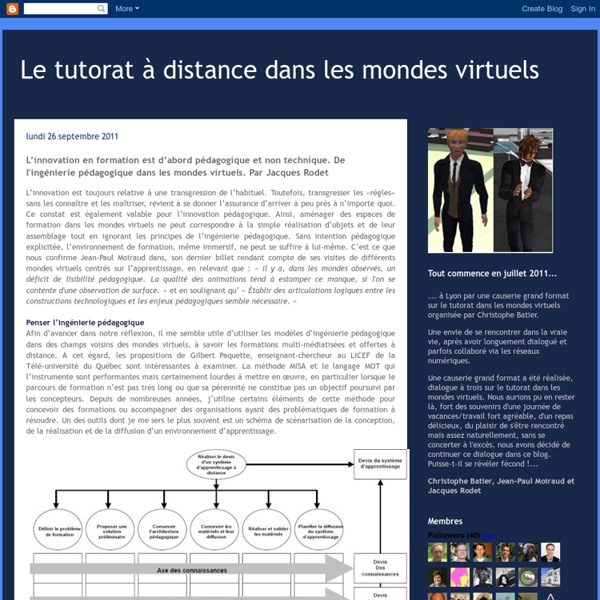



http://tutvirt.blogspot.com/2011/09/linnovation-en-formation-est-dabord.html
Related: Formateur • Méthodologie du e-learning • AFEST - TUTORAT- ACCOMPAGNEMENT A DISTANCEOnline social networks as formal learning environments: Learner experiences and activities George Veletsianos and Cesar C. Navarrete University of Texas at Austin, USA Abstract While the potential of social networking sites to contribute to educational endeavors is highlighted by researchers and practitioners alike, empirical evidence on the use of such sites for formal online learning is scant. To fill this gap in the literature, we present a case study of learners’ perspectives and experiences in an online course taught using the Elgg online social network. Here Are Ten Rules to Create Engaging Elearning At the recent ASTD conference, I was asked how to create engaging elearning. If you’ve been reading the Rapid E-Learning Blog for a while, then you know I’ve tackled this subject before. I decided to pull ten ideas that are fundamental to building good elearning courses. Rule 1: Don’t Create the Course This is probably not the advice your client wants to hear. But let’s face it; there’s quite a bit of elearning that’s just a big waste of time.
Welcome to the Virtual Crash Course in Design Thinking Welcome to the d.school’s Virtual Crash Course resource page! We know not everyone can make a trip to the d.school to experience how we teach design thinking. So, we created this online version of one of our most frequently sought after learning tools. Teaching time investment: Does online really take more time than face-to-face? Rebecca Van de Vord and Korolyn Pogue Washington State University, USA Abstract Enrollments in online programs are growing, increasing demand for online courses. The perception that teaching online takes more time than teaching face-to-face creates concerns related to faculty workload. To date, the research on teaching time does not provide a clear answer as to the accuracy of this perception.
Ten Tips for Personalized Learning via Technology At Forest Lake Elementary School, in Columbia, South Carolina, the student population grows more diverse by the day. Income levels, ethnicities, family structures, first languages, interests, and abilities now vary so much, that a traditional teaching approach, with a uniform lesson targeted to the average-level student, just doesn't cut it. (Sound familiar to you educators out there?) To challenge and support each child at his or her own level, the Forest Lake teachers and staff are deploying a powerful array of widely available digital-technology tools. 8 Ideas, 10 Guides, And 17 Tools For A Better Professional Learning Network Personal learning networks are a great way for educators to get connected with learning opportunities, access professional development resources, and to build camaraderie with other education professionals. Although PLNs have been around for years, in recent years social media has made it possible for these networks to grow exponentially. Now, it’s possible to expand and connect your network around the world anytime, anywhere. But how exactly do you go about doing that? Check out our guide to growing your personal learning network with social media, full of more than 30 different tips, ideas, useful resources, and social media tools that can make it all possible.
How People Learn: 8 Timeless Principles for Effective eLearning How People Learn: 8 Timeless Principles for Effective eLearning Effective learning doesn’t require expensive technology and elaborated training sessions. It doesn’t even demand the impossible from you, the course developer. But it does call for a change in mindset. Such change begins once you understand how the human brain really works. Building the Foundation for Blended Learning Success [#Infographic] It used to be that the idea of learning and education was restricted to the brick-and-mortar experience of the traditional classroom. Students filed into a specified building at an exact time, and sat at a desk while taking notes as a teacher lectured. The Internet, however, has changed where and how learning takes place.